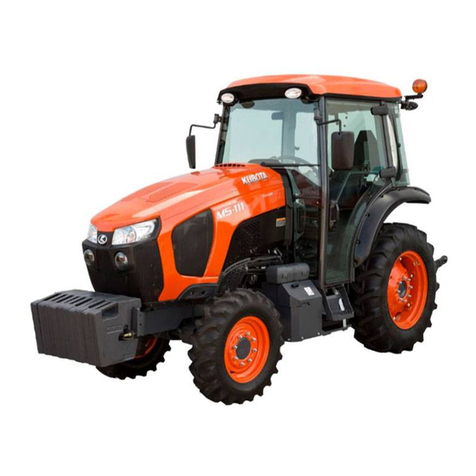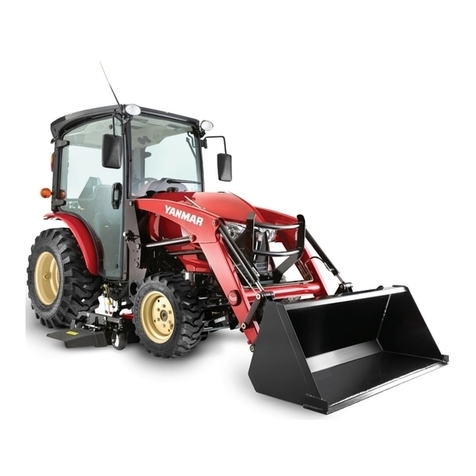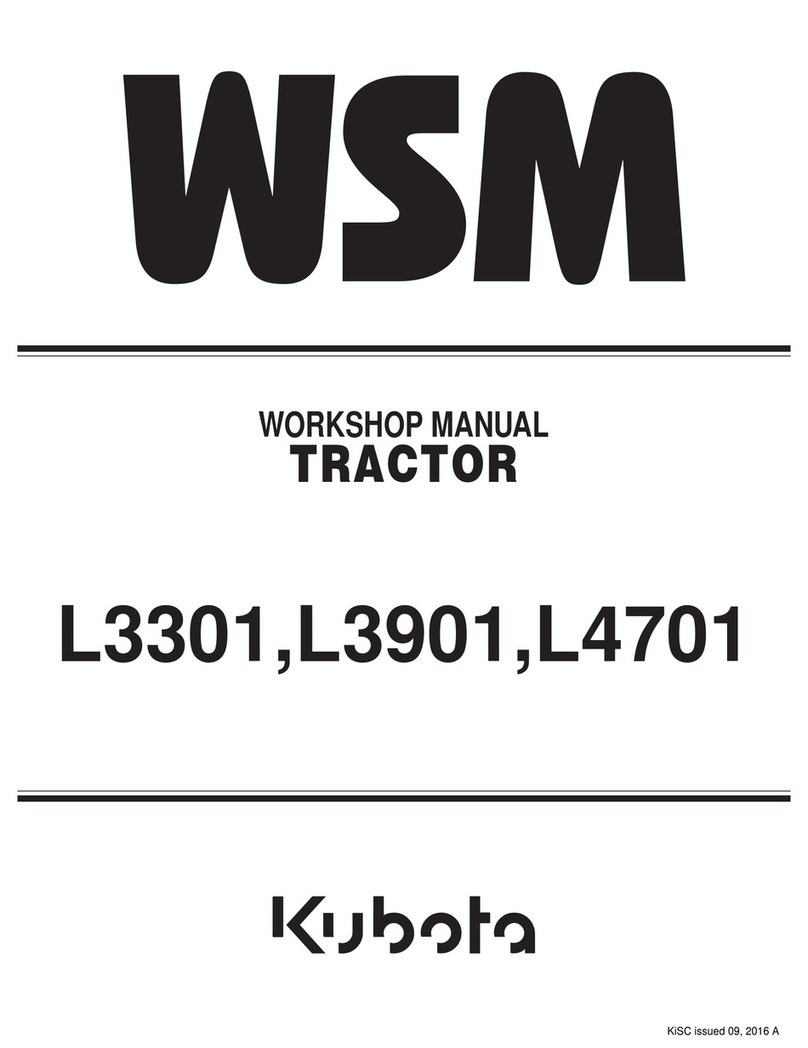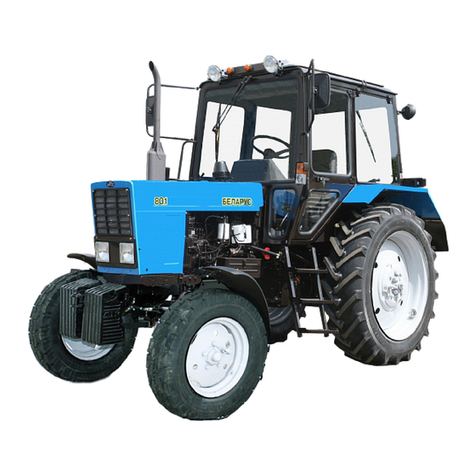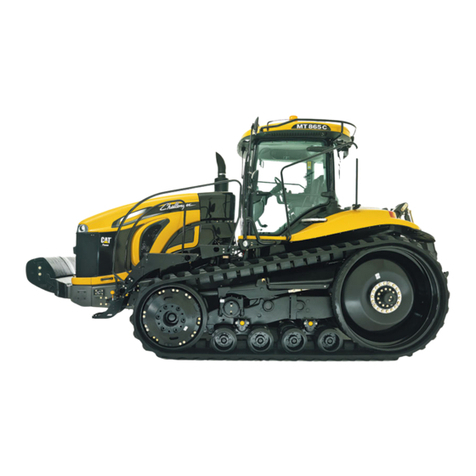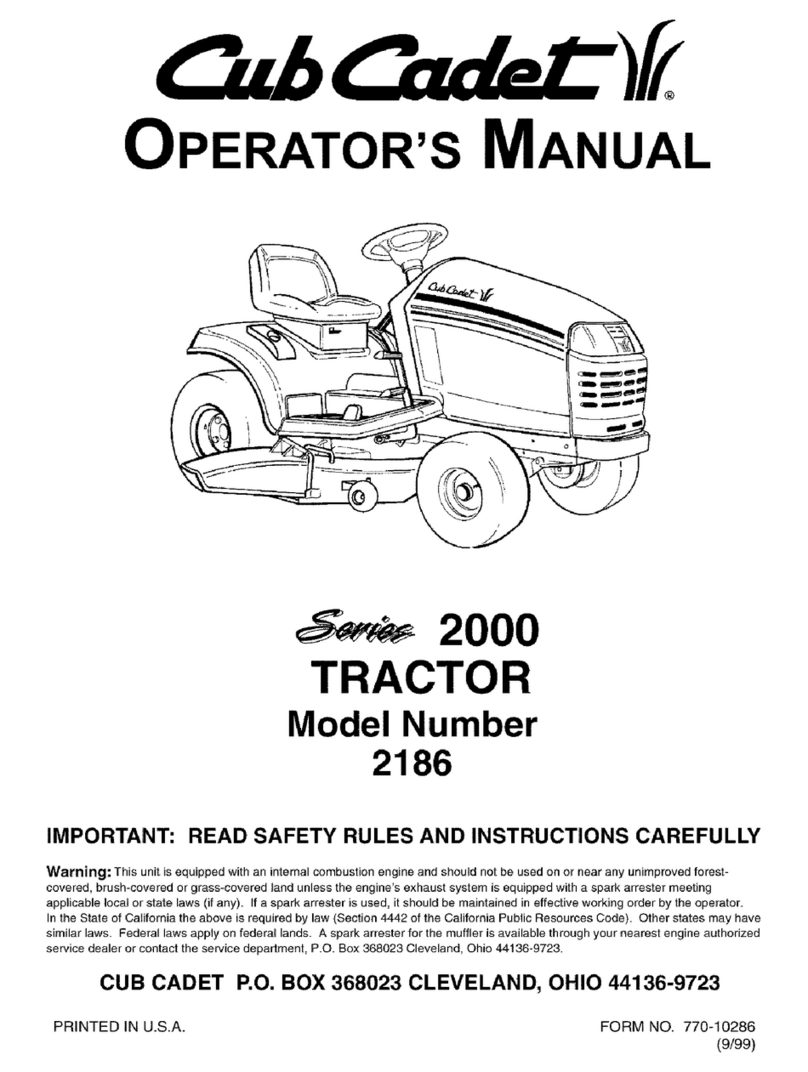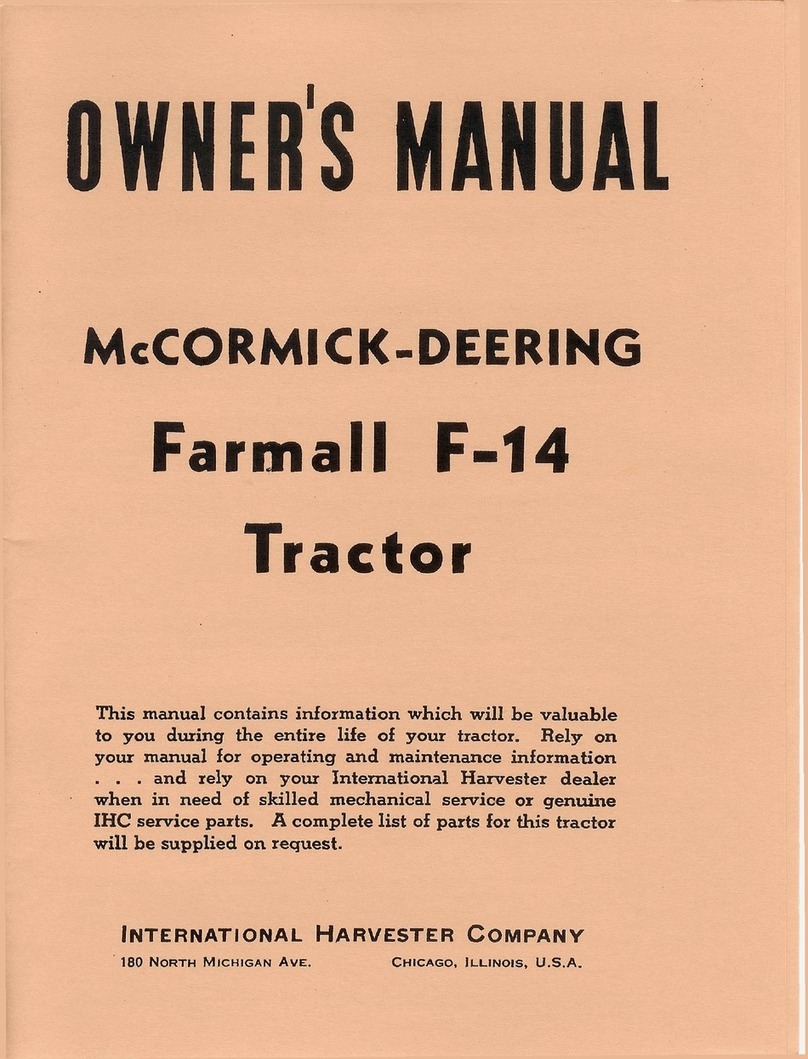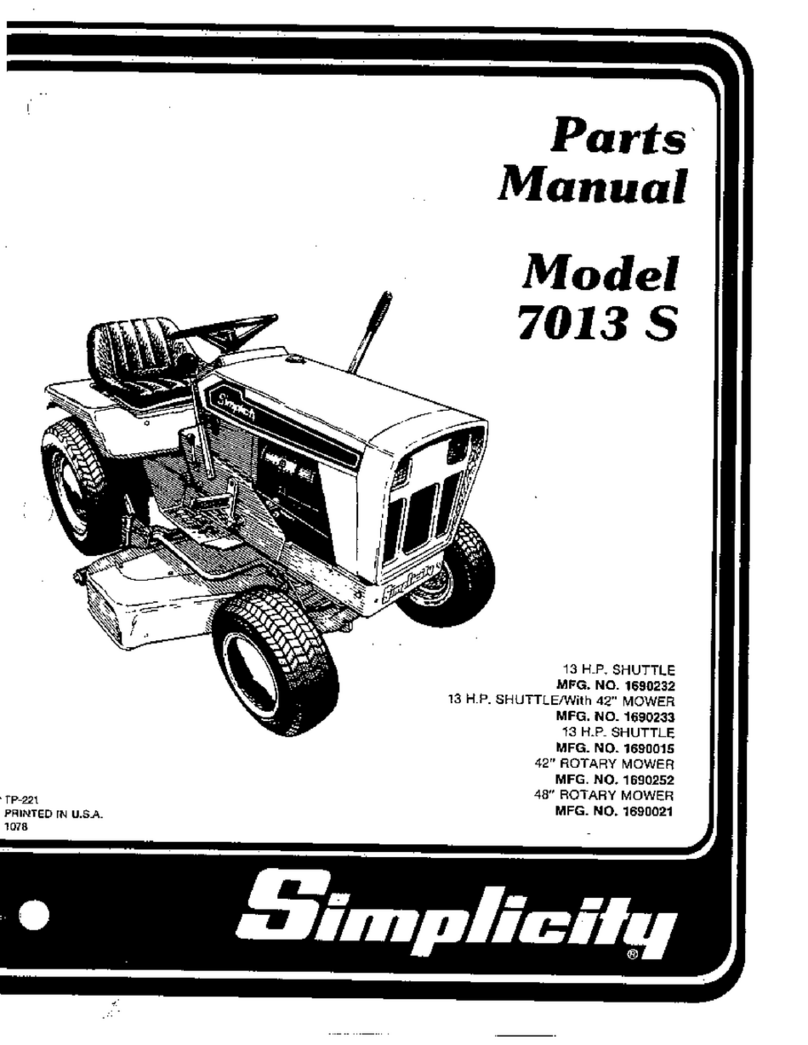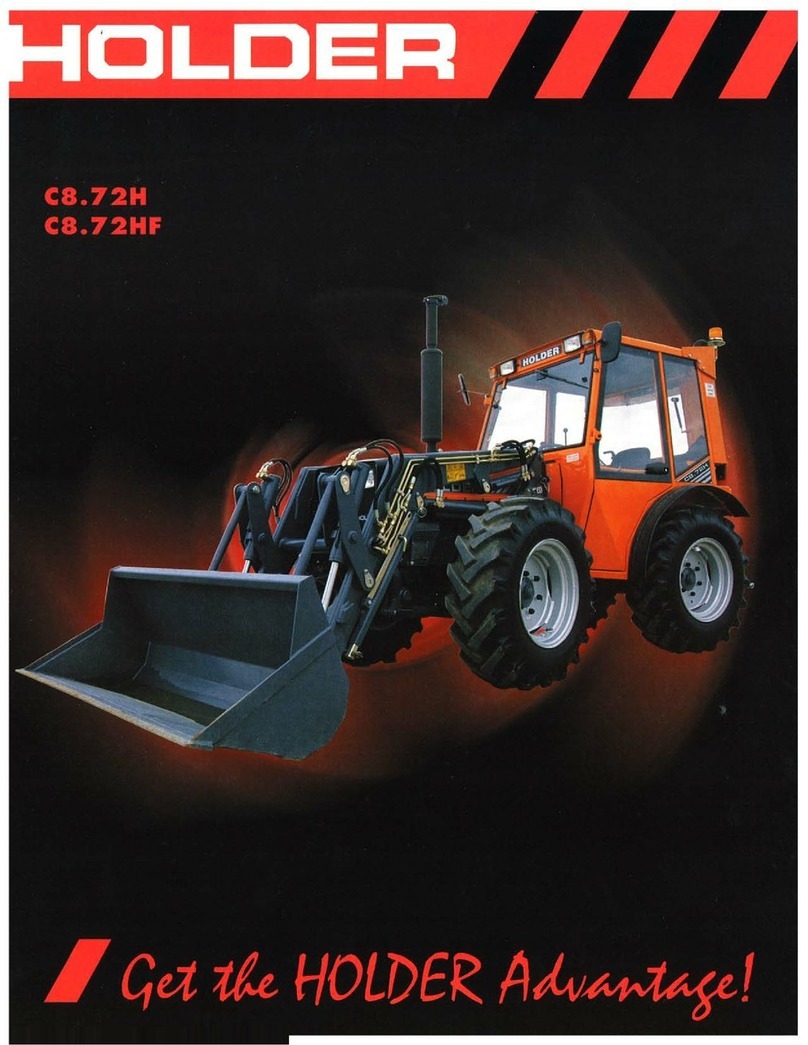A.E.C. Matador 4 x 4 Medium 0853 User manual



BOOK
No.
IOO
jF.W.2A.
DRIVER'S
HANDBOOK
FOR
TRACTOR,
4 x 4
MEDIUM
·
A.
E.
C.
"M
A T
ADO
R"
Model
0853-C.1.
Engine
(Air
Pressure
Assisted
Hydraulic
Brakes).
THE ASSOCIATED EQUIPMENT CO. LTD.
October,
1943.

2.
Fig. 1. Arrangement
of
Chassis.
FUEL
TANK
,
VENT
pIPE

TO DRIVERS.
THIS BOOKLET is to assist you in carrying out your duties
of
driving
and
maintaining the A.E.C.
"Matador"
4 x 4 Medium Tractor. While every care has been taken
in the design
and
manufacture
of
the vehic!e to obtain
maximum mileage between overhauls, certain ' adjustments
and
periodical lubrication are essential to obtain this mile-
age.
To
this end, routine maintenance is divided
into
16
simple tasks, which must be carried
out
regularly
in
sequence so that all the tasks are completed once per fortnight.
Apart from necessary adjustments and lubrication, a vehicle
that is performing satisfactorily should not
be
tampered with
or
any part dismantled, as this may lead to trouble. See to
it that you understand the tasks
and
your vehicle,
and
should you notice anything which may be wrong during your
inspection, report it. Do not overlook anything.
If
your vehicle
is
equipped with air pressure braking equip-
ment instead
of
Hydraulic, you should ask
for
Driver's
Handbook
No.
IOO
/
FW
1
or
lOO
jFW3. Hydraulic brakes
may be identified by the servo motor mounted inside the O.S.
chassis
member;
air pressure brakes are
not
fitted with a
servo motor.
3

4
General
Data
Controls
,CONTENTS.,
Starting
and
Driving Instructions '
Frost
Precautions
Instructions for using
the
Winch
Periodical Attention (items not covered
by
the Tasks)
Routine Maintenance (Sixteen Tasks)
Task No. 'I- Engine ,,
Task No. 2- Engine Lubrication
Task No. 3- Engine Cooling System
Page
5
7
11
16
19
22
25
26'
28
30
Task No. 4-
Fuel
Supply System
31
Task
No.
S
~
Engine
Contr~ls
,
. . 35
Task No. 6- f These Tasks do
not
apply to this vehicle
Task No. 7- l they are replaced
by-Winch.
36
Task
No. 8- Steering
Task No. 9- Charging System (Electrical)
Task No.
10
-
Sta~ter
Motor
and
Lights
Task No.
ll
-Clutch
and
Gearboxes
Task
No. 12-Transmission Universal Joints
and
Axles
Task
No. 13-Chassis
and
Road
Springs
Task No.
I4
-Body
Task No.
IS-Brake
System
Task No.
I6
-Tyres and Tools
Special Tools
..
37
38
39
39
42
44
45
46
54
55
57
Running Faults and General Hints
Lubrication Chart fnside rear cover

GENERAL DATA. 5
Vehicle designation
..
Engine
Oil pressure (gauge on dash)
Engine Cooling System
Fuel
Tank
Electrical System
Batteries
Brakes
Air pressure (gauge on dash)
Tyres
Tractor,
4x4
Medium A.E.
C."Matador."
A.E.C. 6-cylinder C.l. Engine.
60
lb
./
sq. inch
at
maximum governed
speed (1,800 R.P.M.)
6 gallons, when using water,
or
I in.
below level
of
top
rim
of
strainer when
using anti-freeze mixture.
Capacity 40 gallons. 34 gallons in main
tank, 6-gallons in reserve compartment.
Main
tank
measured by gauge
on
side.
Reserve
Tank
measured
by
observation
through filling hole.
Lighting
and
auxiliaries 12-volts.
Dynamo
and
starter
motor
24-volts
No
ammeter
fitted;
warning light
o(
electrical control unit goes
out
wher -
dynamo is charging.
Four
6-volt units connected in series
to
supply 24-volts for starting
and
12-volts
for lighting
and
auxiliaries. Electrolyte
to be t in. above
top
of
plates.
Lockheed Hydraulic assisted
by
Air
Pressure. Separate cylinder to each
road
wheel.
80-90 lb./sq. inch (Westinghouse).
95-100 lb. /sq. inch (Clayton-Dewandre).
Size-13.50 in. x 20 in. Single low pressure
Bar tread.
LUBRICANTS AND CAPACITIES
FOR
MAIN
UNITS.
Unit. Service Type Capacity.
Lubricant.
--
Engme .. ·. .. Oil
30
H.D. 6 gallons.
Fuel-injection
pump
·.
OiI30H
.D. ! pint.
Fuel-injection pump governor ·. Oil 30 H.D. t pint.
Main gearbox ·. ·. ·. Oil C. 600 If gallons.
Auxiliary gearbox ·. ·. ·. Oil C. 600 3! gallons.
Front
axle .. . .
..
..
Oil C. 600 It gallons.
Rear
axle (worm and bevel types) . . Oil C. 600 It gallons.
Steering box ·. ·. Oil C. 600 I! pints.
Oil bath air cleaner
..
·. ·. Oil
30
H.D. t pint.
Change-speed box ·. ·. ·. Oil C. 600 I pint.
Winch casing ·. ·. ·. Oil C. 600 ! gallon.
Air compressor ·.
..
Oil
30
H.D. J! pints.
Trailer brake air cylinder ·. ·. Oil
30
H.D. ! pint.
Servo
motor
(Clayton Dewandre)
only .. · .
OiI30H.D.
1 pint.
..
For
all
chaSSIS
POll1ts
requiring lubrication and for the Service type
of
lubricant to be
lIsed,
see Lubrication Chart inside rear cover
of
this book.

Fig. 2. Driver's Controls.
KEY
TO
INDEX
NUMBERS.
1. Accelerator Pedal.
2.
Brake
Pedal.
3. Clutch Pedal.
4.
Hand
Brake Lever.
5. Winch
Brake
Lever.
6.
Gear
Lever
(Main
Gearbox).
7.
Gear
Lever (Auxiliary
Gear-
box).
8.
Four
Wheel Drive Lever.
9. Winch Clutch Lever.
10. Engine Speed Control
Hand
Lever.
12.
Ether
Starting Device.
13.
Ether
Starting Butterfly Valve
Control.
14. Battery
Cut-out
Switch.
15. Electrical
Control
Unit
(C.A.V
.)
(For Simms' Electrical
Control Unit, see Fig. 40).
16. Starter Button.
17.
Dynamo
Indicator
Light.
18. Tail
Lamp
Switch.
19. Side
Lamp
Switch.
20. Head
Lamp
Switch.
21. Starting Switch.
22. Inspection
Lamp
Connection.
24. Oil Pressure Gauge.
25. Air Pressure Gauge.
26. Speedometer.
27. Instrument Panel Light
Switch.
28.
Horn Push.
29.
Warner
Brake Controller.

7
CONTROLS.
(The index numbers correspond to those in Fig. 2, unless otherwise stated).
FOOT
1.
Accelerator.
The
right-hand pedal operates the fuel injection
pump
and
thus
controls the speed
of
the engine. Depress pedal fully when starting
engine. Lift with toe, to
stop
engine.
2. Brake.
The centre pedal operates the brakes
on
all four wheels.
3.
Clutch.
The left-hand pedal operates the clutch.
Do
not
rest foot
on
this
pedal when driving
and
do
not
hold clutch
out
to coast.
HAND.
4.
Brake.
This
is
the longer
of
the two levers
on
the driver's right,
and
operates the brakes
on
rear
wheels only.
To
apply brake, pull lever
back;
to release brake, grip the trigger lever
and
return
hand
lever·
to
forward position.
S.
Winch Brake,
Just behind the
hand
brake lever, the shorter
of
the two.
It
should always be in
the"
on
" position (back) except when winching.
6.
Gear Lever (Main Gearbox).
The long lever on left
of
driver
and
opposite the
hand
brake lever.
It
is used for changing
the
gears in the
main
gearbox to obtain different
speeds.
To
engage reverse gear, lift knob
at
top
of
lever
and
push
over to
your
left side
as
far as it will go, then pull towards the rear.
The movements
of
the
gear lever
to
obtain
the various gears are
indicated
on
a plate
on
top
of
the bonnet.
01
(3
02
04
Fig. 3. Gear Positions (Main Gear Lever).

7.
Gear Lever (Auxiliary Gearbox).
The outside ball handle lever
at
right
of
the driver.
It
is
used for
changing
th~
auxiliary gear to high,
or
low. High gear is always used
for normal road
work;
low
or
high gear may be used with four wheel
drive. Low gear
cannot
be engaged unless front wheel drive
is
also
used.
Movement
of
lever
is
:-
Up
for low gear.
Central for neutral (position for winching).
Down
for high gear.
8.
Four Wheel Drive Lever.
The
inside ball handle lever
at
right
of
the driver is for engaging
four wheel drive
or
rear wheel drive only.
Rear wheel drive is always used for normal road work.
Movement
of
lever is
:-
Up
for four wheel drive.
Down
for rear wheel drive.
9.
Winch Clutch Lever.
This
is
on
the driver's left
at
the rear.
Movement
of
lever is :-
Up
for clutch out.
Down
for clutch in.
Except during winching, this lever must be
in
the"
up " position
in the clip provided.
10.
Engine Speed Control Hand Lever.
The
small lever mounted on the side
of
the bonnet to the left
of
the
driver.
Tt
is
used
to
regulate the speed
of
the engine, as during
winching, without the necessity for keeping foot on the the accelerator
pedal.
It
must be in the shut position (down) before the engine can
be stopped,
by
lifting the accelerator pedal.
11.
Winch Engagement Lever (Fig.
1).
Mounted
on
the auxiliary gearbox
on
the nearside
of
the vehicle.
Move forward to engage winch drive.
12.
Ether Starting Device (when fitted).
This
is
mounted
on
the left side
of
the driver's seat
and
is
operated
by a lever
(for
instructions see page 12).
13.
Ether Starting Butterfly Valve Control (when fitted).
The small knob
at
the rear
on
the .driver's side
of
the bonnet (for
instructions see page 12).

,
1-
9
14.
Battery Cut-out Switch (C.A.V.)
Knob
on
outer face
of
the electrical control unit.
It
must be
presse.d ..
in"
before
s~arting
the
engine;
when it
is
"out"
the
the battery
is
isolated from all electrical wiring ceyond the feeds to
the Electrical Control Unit.
(For
illustration
of
Simms' Electrical
Control Unit, see Fig. 40).
15.
Electrical Control Unit. (Units
of
C.AY.
and Simms' manufacture
are fitted, the controls
of
which are dissimilar. A
C.AY.
unit is
shown
in
Fig. 2, while Fig. 40
on
page 58, shows a Simms' unit.)
On
right-hand side
of
driver.
In
the panel
on
top
of
this unit are
the following
:-
16.
Starter Button.
Push in to start the
engine;
after closing (14) and (21).
17.
Dynamo Indicator Light.
This should only glow red when the battery cut-out switch (14)
and the starting switch (21)
are"
closed"
and
the engine
is
stationary
or
idling.
If
the light appears when the engine
is
running fairly fast.
the dynamo
is
not
working and it must be reported
at
once.
18.
Tail Lamp Switch. This also controls the axle flood lamp.
19.
Side Lamp Switch.
20. Head Lamp Switch.
The movements for operating these switches are indicated on the
panel.
21. Starting Switch.
This must be
switched"
on
" before the starter button will
operate;
it must be left in this position while the engine
is
running. When
the vehicle
is
not
in use, it
must be switched
"off"
and
the engine stopped by lifting
the accelerator pedal.
22. Inspection Lamp Connection.
Two sockets to
ta
kethe
2-pin plug attached to the
inspection lamp supplied.
The battery cut-out switch
(14) must
be"
in"
to use
this lamp.
23.
Rear Axle Flood
Lamp
Switch (Fig. 4).
This
is
mounted
on
the
rear cross-member.
To change over from tail
lamp to axle flood lamp, Fig. 4. Rear
Axle
Flood Lamp Switch.

10
move the lever to the
left;
to cut
out
the axle lamp and operate the
tail lamp, move lever to the right.
The switch
marked"
tail"
(18)
on
the electrical control unit must
be "
on
" for either the axle lamp
or
tail lamp to operate.
INSTRUMENTS.
On
the instrument panel
just
in front
of
the steering wheel are
mounted the following instruments :-
24.
Oil Pressure Gauge.
This registers lubricating oil pressure,
not
the quantity
of
oil in the
engine.
It
should read
60
lb.jsq. inch when the engine
is
running
at
the maximum governed speed
of
J,800 R.P.M.
25.
Air Pressure Gauge.
This indicates
the
amount
of
air pressure available for braking.
It
should normally read between
80
and 90
Ib.
/sq. inch (Westinghouse)
or
95
and 100 lb. /sq. inch (Clayton-Dewandre) (See
page
19).
26
. Speedometer.
This registers the speed
of
the vehicle
and
total mileage.
Note.-Early
vehicles
had
additional gauges showing the Radiator
water and Engine oil temperatures.
27. Instrument Panel Light Switch.
28. Horn Push. This is mounted
on
top
of
the bonnet.
29.
Warner Brake Controller.
Although ilJustrated
in
Fig.
2,
this controlJer
is
only fitted to the
front dash
on
vehicles having air pressure braking.
On
other vehicles
it
is mounted
in
the chassis frame adjacent to the Servo
Motor
(see
Fig. 31).
30.
Fuel Cock (Fig. 5).
Mounted
on
top
of
the fuel
tank
on offside
of
chassis.
It
has
three
positions,
"main,"
"off"
and
" reserve."
Keep
at"
main " position;
use "
reserve"
only
in
an
emergency
and
return to
"
main"
as soon as tank
is
filled again.
Do not turn to
"oft'''
posi-
tion except
when
dismantling
fuel piping.
Fig.
5.
Fu
el
Co
ck on Fuel Tank.
3
J.
Tyre Inflator (Figs. 7
and
8).
This
is
on
nearside
of
chassis frame just behind the air storage
tank. A flexible tube connection
is
supplied, also a key for turning
on
air. The key can only be removed when the cock
is
in the
"
off"
position.

11
ENGINE STARTING AND DRIVING
INSTRUCTIONS.
A.
Before Starting the Engine, see
that:
(i)
Radiator
is full
of
water, or,
if
anti-freeze solution
is
in use, it
is within 1 in. below the level
of
the
top
rim
of
the gauze strainer.
(ii) Oil
in
the engine sump
is
up
to the
top
mark
of
the dipstick.
(iii)
Fuel
tank
is full
and
cock is
in
"
main"
position.
(iv)
Main
change speed lever
is
in
neutral position.
The
oil level in the sump should be maintained as near
to
the full
mark
as possible as this results in lower oil temperatures
and
higher
lubricating qualities.
B. To
Start
the Engine (Temperatures above
16
deg. F.).
(i) Close the battery cut-out switch (14), Fig.
2.
(ii) Move the starting switch (21) to
the"
on
" position.
(iii) Depress the accelerator pedal fully.
(iv) Press the starter
button
(16) firmly.
(v) Release starter
button
as
soon
as the engine starts.
If
the engine does not pick
up
in a
few
seconds,
do
not
keep
the
starter running as
to
do so will exhaust the
battery;
wait for the
engine to come to rest, then begin again. It will sometimes be .
found necessary
to
keep the accelerator pedal more
or
less fully
depressed for a few moments after the engine starts,
but
as soon
as it has warmed
up
slightly this will
not
be necessary.
(vi) Immediately the engine starts, check the reading
of
the oil pressure
gauge;
it should be approximately 60
[b
./sq. inch.
It
will be
higher
if
temperature is low, but may reduce to
25
lb. /sq. inch
(idling) as the oil warms up.
If
the engine fails to
start,
vent the fuel system (see page 34).
C. To
Start
the Engine (Temperatures near
or
below
16
deg.
F.)
.
When temperatures are sufficiently low to call for the use
of
the Ether
starting device, the felt element in the main fuel filter must be exchanged
for the brass wire gauze type (carried
on
vehicles equipped with Ether
starting device) (see page 34), then proceed as follows
:-

12
(i) Press in
th~
battery
f.:ut-oUI
switch (14) (Fig. 2). '
(ii) Move the starting switch (21) to
the "
on"
position.
(iii) Remove the dummy capsule from
the
"Ethalet
" tool (see Fig. 6).
(iv) Lift the lever
of
the puncturing
tool and insert
"Ethalet"
cap-
sule neck in the recess provided
on the spring platform. Dis-
charge Ether contents
of
capsule
by pressing down the lever with
a quick movement
to
its lowest
position.
(v)
Close starting butterfly valve
by
pulling knob (13), Fig. 2.
(vi) Depress accelerator pedal fully,
and press starter
button
firmly.
(vii) After the engine has fired
and
been firing for 10-30 seconds,
gradually open starting butterfly
valve by pushing in knob (13),
Fig. 2.
If
there
is
a te'ndency for
the engine to stop, immediately
reclose butterfly.
(viii) Continue (vii) until the engine
is
running with starting butterfly
fully open, i.e., knob pressed
in. Fig.
6.
"Ethalet
" Tool.
(ix) Gradually allow accelerator pedal to rise until engine idles
satisfactorily.
(x) Remove the used
"Ethalet"
capsule,
by
lifting the lever to
upper position
and
removing capsule with fingers
at
slotted
opening.
(xi) Replace dummy capsule.
(xii)
If
engine fails to start, insert a second "
Ethalet"
capsule
and
repeat the above procedure.
The felt element must be fitted in place
of
the gauze type in the main
fuel oil filter when warmer conditions exist.
Do not race the engine to warm up, but let
it
fun slowly
at
about
quarter throttle for a few minutes before driving off.

13
When starting from cold in frosty weather, see
that
the blanking flap
is in position
on
the lower
portion
of
the
radiator
front grill. As this
flap will permit the vehicle
to
operate satisfactorily
under
atmospheric
temperatures
up
to
90"
F.,
it
should only be removed
if
the vehicle
is
to
operate
in
tropical climates.
D.
To
Stop
the Engine.
Lift the accelerator pedal with the toe,
and
hold
in raised position
until the engine stops.
GENERAL HINTS ON DRIVING.
(i)
For
normal
road
conditions use high auxiliary gear
and
rear
wheel
drive,
i.
e., both auxiliary gear levers (7)
and
(8), Fig. 2, in the
"
down"
position.
(ii) Start in 2nd "
main"
gear unless
on
an
up gradient.
(iii)
Do
not
rest
your
foot
on
the clutch pedal when driving
and
do
not
hold the clutch
out
to
coast.
(iv)
Use
"
top"
gear as
much
as possible
and
do
not
change
down
while
the
engine
has
the load well in hand.
When
climbing
hills,
do
not
wait, however, until the engine is labouring before
changing down.
(v)
Do
not
race the engine unnecessarily,
and
when going up a hill in
low gear, change
up
as
soon
as the speed will allow.
(vi)
The
engine is governed to a speed
of
1,800 r.p.m.
under
load
which
limits the speed
of
the vehicle as fa
Haws
:-
ROAD SPEED
IN
M.P.H.
Gear.
7.9:
1 Axle 6.25: 1 Axle For both Ratios
Ratio
with
High Ratio
with
High
with
Low
Auxiliary Gear. Auxiliary Gear. Auxiliary Gear.
1st
..
·. ·. 7 8 3
2nd
·. · .
11
14
5
3rd ·. ·.
19
24 8
4th (Top) " ·. 30
38
13
Note.-Axle
ratios are stamped as shown in Figures
28
and
29.
To Move Off.
Where
road
conditions
are
normal, engage high auxiliary gear
and
rear wheel drive, by pushing down
both
auxiliary gear levers then, after
running the engine
at
about
quarter
speed for a few moments, proceed
as follows :-

14
(i) Depress
and
hold down the clutch pedal.
(ij)
Place"
main"
gear lever in 2nd gear position, i.e., press sideways
away from you, then pull towards the rear.
(iii) Release
hand
brake.
(iv) Allow clutch pedal to come up slowly
and
at
the same time press
down accelerator pedal.
(v)
When the vehicle has reached
about
the speed 5hown in the table
below, press down the clutch pedal
and
at
the same time release
the accelerator pedal.
(vi)
Move"
main"
gear lever to the 3rd gear position, i.e., pushforward
half-way, then pull sideways towards you as far as it will go
and
then move forward.
(vii) Release clutch pedal slowly,
and
at
the same time press down the
accelerator pedal as before.
(viii) When the vehicle has reached the speed shown
in
the following
table, for this gear, repeat the process
and
pull main gear lever into
4th gear position (top).
Changing
UP
with 7.9 : 1 Axle
and
2.31
: 1 Auxiliary Gearbox
ratios:
High Auxiliary Gear.
Low
Auxiliary Gear.
From
To
On
Level.
UphiU.
On
Level.
Uphill.
1st
Gear
\ 2nd
Gear
-7 -3
2nd " 3rd " 8
11
3t
5
3rd " 14th "
14
18
6 8
With 6.25 : 1 Axle
and
2.91
: 1 Auxiliary Gearbox ratios :
1st
Gear
2nd
Gear
I -8 -3
2nd " 3rd " I
11
14
3!
5
3rd " 4th "
19
24 6 8
Changing Gear on Hills.
When moving from rest up hill, instead
of
starting with the main gear
lever in 2nd gear, engage 1st gear
and
change to the 2nd gear when the
speed
is
approximately as given
in
the above table against the appropriate
gear ratio fitted to the vehicle and whether in high
or
low auxiliary gear.
Carry
on
with the
other
gear changes as set
out
above referring to the
appropriate portion
of
the table.

15
When the vehicle
is
climbing a hill
in
4th (top) gear
and
its speed drops,
it
is
necessary to change down into 3rd gear.
To
do this, double de-
clutch as follows
:-
(i)
Release the accelerator pedal.
(ii) Press down the clutch pedal
and
at
the same time move the gear
lever into neutral.
(iii) Release the clutch pedal,
at
the same time pressing down the
accelerator pedal for a moment
and
then releasing it. (This is to
bring the engine speed up to the same as the vehicle speed for the
gear
about
to be engaged.)
(iv) Press down the clutch pedal
and
move the gear lever into the lower
gear position.
(v)
Release clutch pedal smoothly
and
press down accelerator pedal.
The following table gives a guide to the speeds
at
which the gear
should be changed
DOWN
when the vehicle
is
travelling
up
hill
:-
7.9:
1
with
6.25: 1
with
For
both
Ratios
From
To
High Auxiliary High Auxiliary
with
Low
Gear. Gear. Auxiliary Gear.
4th (Top) 3rd 20 26 9
3rd 2nd 12
15
6
2nd 1st 7 8 4
You must stop the vehicle to change auxiliary gear
or
to engage four
wheel drive or rear wheel drive.
To Stop the Vehicle.
(i) Release the accelerator pedal
and
depress brake pedal.'
(ii) When the vehicle has slowed down to a speed
of
approximately
10
m.p.h., press down the clutch pedal
and
move the
main
gear
lever into neutral. Then release the clutch pedal.
(iii) When the vehicle
is
stopped, pull
on
the
hand
brake
and
release
brake pedal.
B~fore
leaving the Vehicle
at
night
:-
(i)
Appl/
hand
brake.
(ii) Place main gear lever
in
"
neutral"
position.
(iii) Stop the engine by lifting the accelerator pedal.
(iv) Switch off lights
and
the switch marked
"start"
on
electrical
control unit.
(v) Pull
out
the battery cut-out switch.

16
(vi) In cold weather,
See
thatCrost precautions are observed (see below).
(vii) Open both drain cocks on air storage tank (Figs. 7
and
8),
until clear
of
all air and moisture, then close
and
remove handles. The
handles can only be removed when the cocks are closed.
Fig. 7. Air Storage Tank (Westinghouse).
Fig.
8.
Air
Storage Tank (Clayton-Dewandre).
FROST PRECAUTIONS.
(A)
PROTECTION
BY
USE
OF
ANTI-FREEZE MIXTURE.
Vehicles with anti-freeze mixture in the engine cooling system have
an
identification
mark
in
the form
of
a disc painted in a specified colour
on
the front
of
the vehicle.

If
your vehicle
is
so marked, your instructions are as follows :-
(i)
Do not drain the cooling system unless instructed to do so.
17
(ii)
If
the cooling system has to
be
emptied, see that you have the right
number
of
containers
at
hand before draining, and collect the
mixture for re-use (approximately 6 gallons).
(iii)
Top
up
the radiator with anti-freeze solution
(NOT
WATER)
when the engine is hot.
(iv)
Top
up to 1 in. below the
top
rim
of
the strainer. Do not
over-fill.
(v)
If
for any reason the mixture
is
lost and the system
is
filled with
water, paint out the coloured disc.
Brake Anti-freezer:
To
prevent the valves
of
the air compressor
and various other units in the air pressure system, from freezing in severe
weather, the anti-freezer fitted
to
the nearside chassis frame must be
filled
with"
I.M.S.
wbstitute"
or
"Methanol"
when frost precautions
are ordered,
and
the operating cap must be pulled up (see Fig. 38).
(B)
PROTECTION
BY
DRAINING .
THE
ENGINE COOLING
SYSTEM
(where anti-freeze is
not
used).
If
anti-freeze solution
is
not
available
and
the vehicle is
to
remain
standing
in
the open with temperatures approaching freezing point,
the cooling system must be completely drained as follows:
THERMOSTAT
SHUT
RADIATOR
RADIATOR
OVERFLOW
PIPE
Mr
~
~=$~~~
~~~~~
~"WATER
INLET
- -
___
- .
PIPE
DRAIN
I ( PLUG
CYLINDER
BLOCK
V--,
I
DRAIN
COCK
&
PIPE
~
I
DRAIN
COCK
WATER
PUMP
DRAIN
COCK
Fig
. 9. Diagram
of
Water C
oo
ling System

18
(i)
Drain
points are positioned as follows
:-
(a)
Radiator
bottom
tank
(drain cock).
(b) Water pump body (drain cock).
(c)
Nearside
rear
of
cylinder block (drain cock).
(d)
Water inlet pipe
at
rear
of
cylinder block (drain plug).
Fig. 9 shows
the
positions
of
these four drain points, all
of
which
must be opened
to
drain the system completely.
(ii)
Drain
cocks
must
be tested
at
frequent intervals by inserting a piece
of
wire
to
ensure
that
they are clear. This should be done im-
mediately they are opened so
that
any obstruction freed by the
wire may be flushed
out
by the water.
(iii)
Drain
when the engine
is
hot
and
do
not
leave the vehicle until the
water
is
properly drained from all points. Close the cocks
and
replace the plug when drained.
(iv) After draining, place a notice
on
the
radiator
to
the effect
that
it
is
empty.
BRAKES.
Four
wheel brakes are provided for the foot brake, using the Lock-
heed hydraulic system, assisted by
an
air pressure servo.
The
air supply
for the foot brake is obtained
by
a compressor driven off the main gear-
box ;
it
is important, therefore, that the vehicle is not coasted
in
"
neutral"
when descending long hills, as although the supply
tank
is
of
large
capacity, the
amount
of
braking under these conditions would reduce the
supply, the compressor being idle.
The hand brake
is
operated
by
mechanical linkage
on
the rear wheels
only,
and
actuates the same shoes as the foot brake.
When descending long hills,
the
hand
brake should be used
and
the
foot brake 'lpplied occasionally as required. The resistance,
or
com-
pression,
of
the engine should be used as much as possible to assist in
braking, by taking
your
foot off the accelerator pedal and leaving the
vehicle in gear, so
that
the
road
wheels have then to keep the engine
turning against the compression
of
the engine.
On
steep hills this help
must be increased
by
using a lower gear, using the same gear ratio
that
would be required
to
climb the hill,
but
care
must
be
taken
that
the
vehicle is
not
allowed
to
run
too
fast (see
page
13).
To Recharge the Storage Tank.
The
drain cocks
on
the storage
tank
must be opened every 24 hours
(normally every night)
in
order
that
moisture caused by condensation
is
released; the first time the engine is started afterwards will cause the air
compressor to recharge the supply tank. See that the main change
speed lever is in "
neutral"
and run the engine
at
about quarter throttle
(do not touch clutch pedal).
Table of contents
